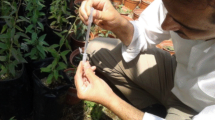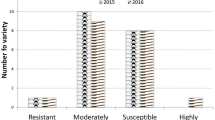Abstract
Phytic acid (PA), though an antinutritional factor that causes mineral deficiency in monogastric animals but also reported to be associated with expression of stress tolerance genes. The present study was conducted to find out association of seed PA with tolerance to yellow mosaic disease (YMD), powdery mildew disease (PMD) and storage pest bruchid in mungbean. Ninety four genotypes were screened for YMD by using infector rows technique in summer 2011 and 2012 and PMD screening was done in rabi 2012 in the field conditions and using excised leaf technique in growth chamber. Screening for bruchid (Callosobruchus chinensis L.) was carried out by following standard procedure. PA and inorganic phosphorous (IP) were estimated from seeds by colorimetric method and Chen’s modified method respectively. Among 94 genotypes, 47 were found susceptible while out of 47 resistant genotypes, 37, 9 and 1 were found resistant to YMD, PMD and bruchid respectively. PA was found to be highest in bruchid resistant genotype followed by PMD and YMD. Along with the resistance genes, high seed PA (>8 mgg-1) was required for resistant reaction to YMD and PMD, while for bruchid resistance very high PA (~18 mgg-1) should be present in seeds. If the concentration of PA is reduced below this level my leads to decrease in tolerance to biotic stresses, even though the resistance gene is present in the plant.
Similar content being viewed by others
References
Anonymous. (2015). Project coordinator’s report (mungbean and urdbean) 2014-15. All India coordinated research project on MULLaRP. Kanpur, India: Indian Institute of Pulses Research.
Bregitzer, P., & Raboy, V. (2006). Effects of four independent low phytate mutations on barley agronomic performance. Crop Science, 46, 1318–1322.
Brown, K. H., & Solomons, N. W. (1991). Nutritional problems of developing countries. Infectious Disease Clinics of North America, 5, 297–317.
Chen, P. S., Toribara, T. Y., & Warner, H. (1956). Micro determination of phosphorus. Analytical Chemistry, 28, 1756–1758.
Dahiya, P. K., Linnemann, A. R., Nout, M. J. R., Boekel, M. A. J. S., & Grewal, R. B. (2013). Nutrient composition of selected newly bred and established mungbean varieties. LWT - Food Science and Technology, 54, 249–256.
Debnath, D., Sahu, N. P., Pal, A. K., Baruah, K., Yengkokpam, S., & Mukherjee, S. C. (2005). Present scenario and future prospects of phytase in aquafeed -review. Asian-Australasian Journal of Animal Sciences, 18, 1800–1812.
Dhole, V. J., & Reddy, K. S. (2013). Development of a SCAR marker linked with a MYMV resistance gene in mungbean (Vigna radiata L. Wilczek). Plant Breeding, 132, 127–132.
Dhole, V. J., & Reddy, K. S. (2015). Genetic variation for phytic acid content in mungbean (Vigna radiata L. Wilczek). The crop Journal, 3, 157–162.
Dongre, T. K., Pawar, S. E., Thakare, R. G., & Harwalkar, M. R. (1996). Identification of resistant source to cowpea weevil [Callosobruchus maculatus (F.)] in Vigna sp. and inheritance of their resistance in black gram (Vigna mungo var. mungo). Journal of Stored Products Research, 32, 201–204.
Ertl, D. S., Young, K. A., & Raboy, V. (1998). Plant genetic approaches to phosphorus management in agricultural production. Journal of Environmental Quality, 27, 299–304.
Gao, Y., Shang, C., Saghai Maroof, M. A., Biyashev, R. M., Grabau, E. A., Kwanyuen, P., Burton, J. W., & Buss, G. R. (2007). A modified colorimetric method for phytic acid analysis in soybean. Crop Science, 47, 1797–1803.
Green, E. S., Zangerl, A. R., & Berenbaum, M. R. (2001). Effect of phytic acid and xanthotoxin on growth and detoxification in caterpillar. Journal of Chemical Ecology, 27, 1763–1773.
Hande, P., Mondal, S., Badigannavar, A. M., & D’Souza, S. F. (2013). Genetic variability of phytic acid- phosphorus and inorganic phosphorus in cultivated groundnut (Arachis hypogaea L.). Plant Genetic Resources: Characterization and utilization, 1-6.
Khattak, G. S. S., Haq, M. A., Rana, S. A., Abass, G., & Irfag, M. (2000). Effect of mungbean yellow mosaic virus (MYMV) on yields and yield components of mungbean (Vigna radiata L. Wilczek). Kasetsart Journal (Natural Sciences), 34, 12–16.
Latta, M., & Eskin, M. A. (1980). Simple and rapid colorimetric method for phytate determination. Journal of Agricultural and Food Chemistry, 28, 1315–1317.
Marzo, F., Andres, A., Maria, V. C., & Ruben, A. (1997). Fertilization effects of phosphorus and sulfur on chemical composition of seeds of Pisum sativum L. and relative infestation by Bruchus pisorum L. Journal of Agricultural and Food Chemistry, 45, 1829–1833.
Murphy, A. M., Otto, B., Brearley, C. A., Carr, J. P., & Hanke, D. E. (2008). A role for inositol hexakisphosphate in the maintenance of basal resistance to plant pathogens. The Plant Journal, 56, 638–652.
Reddy, K. S., Pawar, S. E., & Bhatia, C. R. (1987). Screening for powdery mildew (Erysiphe polygoni DC) resistance in mungbean (Vigna radiata L. Wilczek) using excised leaves. Proceedings of Indian Academy of Science (Plant Science), 97, 365–369.
Reddy, K. S., Pawar, S. E., & Bhatia, C. R. (1994). Inheritance of powdery mildew (Erysiphe polygoni DC) resistance in mungbean (Vigna radiata L. Wilczek). Theoretical and Applied Genetics, 88, 945–948.
Singh, M., & Krikorian, A. D. (1982). Inhibition of Trypsin Activity in Vitro by Phytate. Journal of Agricultural and Food Chemistry, 30, 799–800.
Sompong, U., Kaewprasit, C., Nakasathien, S., & Srinives, P. (2010). Inheritance of seed phytate in mungbean (Vigna radiata L. Wilczek). Euphytica, 171, 389–396.
Srinivasan, T., & Durairaj, C. (2007). Biochemical basis of resistance in rice bean, Vigna umbellata Thunb. (Ohwi and Ohashi) against Callosobruchus maculatus F. Journal of Entomology, 4, 371–378.
Acknowledgments
The authors are grateful to Dr. S. P. Kale, Head, NABTD, BARC, Mumbai, for his guidance and support throughout this research work. We are especially thankful to Mr. S. M. Bhatkar and P. N. Thokal for the help in conducting the field experiments.
Author information
Authors and Affiliations
Corresponding author
Rights and permissions
About this article
Cite this article
Dhole, V.J., Reddy, K.S. Association of phytic acid content with biotic stress tolerance in mungbean (Vigna radiata L. Wilczek). Phytoparasitica 44, 261–267 (2016). https://doi.org/10.1007/s12600-016-0514-5
Received:
Accepted:
Published:
Issue Date:
DOI: https://doi.org/10.1007/s12600-016-0514-5




